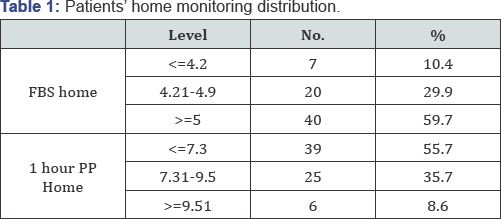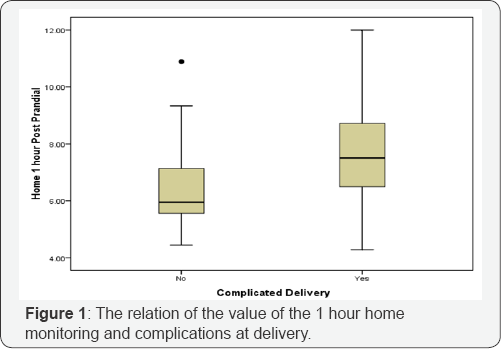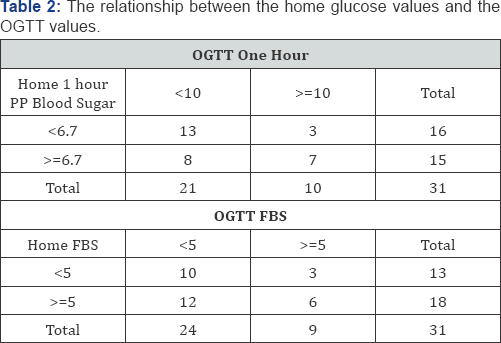Juniper Publishers: Home Blood Glucose Monitoring in Pregnancy and its Relation to OGTT and Pregnancy Outcome
JUNIPER PUBLISHERS- JOURNAL OF GYNECOLOGY AND WOMEN’S HEALTH
Journal of Gynecology and Women’s Health-Juniper Publishers
Authored by Latifa Baynouna*
Abstract
Influence of glucose level on pregnancy outcome was well studied. This study describes blood glucose home monitoring of pregnant Emirati women and its association with OGTT and pregnancy outcome.
Method: Seventy-five non-diabetic low risk mid-trimester pregnant women were randomly recruited and followed prospectively for pregnancy and delivery related outcomes.
Results: raised home one-hour postprandial blood glucose readings were significantly associated with complicated deliveries (t-test; p<0.004). Additionally, home monitoring values showed no correlation with the OGTT values.
Conclusion: Home monitoring performed well in predicting adverse outcome in this population and had no correlation with the OGTT
Keywords: Blood glucose; Pregnancy; OGTT; Home monitoring; Pregnancy outcome
Introduction

Hyperglycaemia may result in adverse pregnancy outcomes. These outcomes are occurring from early trimester to later pregnancy, delivery, postnatal and later on child life [1-6]. Preventing these sequelae requires diagnostic test that can identify high-risk women and pregnancies in order to institute a suitable program to manage the hyperglycaemia (Table 1).
OGTT was the test first used to find this correlation between hyperglycaemia and pregnancy outcome [7]. Nevertheless, the use of OGTT was challenged in spite of its high sensitivity and specificity, mainly because it is done once and blood glucose variability is high and depends on many factors. Also adverse outcomes may still occur below standard OGTT cut-off point. Such false reassurance is higher in populations with high prevalence of hyperglycaemia, resulting in lost opportunities for intervention.
In the United Arab Emirates women are having high prevalence of precursor conditions for diabetes, such as prediabetes, obesity, and vitamin D deficiency [8]. Therefore, hyperglycaemia may be manifest in high numbers and early in pregnancy.
In this report we describe the use of home monitoring in measuring blood glucose in pregnant Emirati women and the association of the reading to OGTT and pregnancy outcome.
Methods
Seventy-five pregnant women from 20-33 weeks of pregnancy recruited from the community during their routine antenatal visits to 5 Al Ain city primary health care centres between 1st October, 2010 to 31st March, 2011 as part of a control group in a study to investigate effect diet restriction on 1 hour postprandial glucose levels [9], both fasting and 1hr postprandial home glucose tests were done. Included were healthy UAE national women who had one or more glucose tests, during their pregnancy and delivered at Tawam hospital, the tertiary care hospital in the city.
Then women were followed prospectively for pregnancy and delivery related outcomes and data were gathered from electronic medical records chart audits. Collected data included basic demographics, past obstetric history, vital signs, and results of antenatal investigations, and vital signs, gestational age at delivery, mode of delivery, fetal weight, and admission to SCABU.
This study protocol was approved by Al Ain District human research ethics committee. Data analysis was done by SPSS v 20. Standard univariate statistics, were used for analysis.
Findings


Home one-hour postprandial blood glucose readings were significantly associated with complicated deliveries (t-test; p<0 004) Figure 1. Additionally, home monitoring values showed no correlation with the OGTT (Table 2). There are as many mothers with high home post-prandial blood glucose (>6.7) among the higher than 10 1-hour OGTT as among those with OGTT below 10. Also half of those with normal fasting OGTT have abnormal high home FBS.
Discussion
Although OGTT test results were not significantly associated with delivery complications as it was reported in other study [10], home one-hour postprandial blood glucose readings, however, were significantly associated with complicated deliveries (t-test; p<0.004). The home one-hour postprandial glucose reading appeared to be a good predictor of delivery complications. In contrast the OGTT had no predictive value10. There is a dearth of good studies relating OGTT to home monitoring, and either/both to pregnancy outcome, something of paramount importance in practice. Particularly continuous glucose monitoring may have better diagnostic value [11,12].
Finally, the fact that affordable home monitoring is superior to expensive OGTT in predicting pregnancy outcome, as well as our finding that the two correlate poorly may carry important implications. However, these findings need independent confirmation before their full impact can be outlined.
Conclusion
Home monitoring performed well in predicting adverse outcome and had no correlation with the OGTT
For more open access journals in JuniperPublishers please click on: https://juniperpublishers.com/
For more articles on Gynecology and Women’s Health please click on: https://juniperpublishers.com/jgwh/
To read more......Fulltext in Gynecology and Women’s Health in Juniper Publishers
https://juniperpublishers.business.site/




Comments
Post a Comment